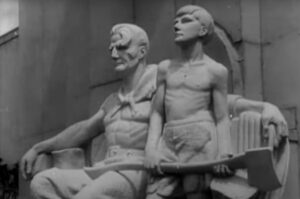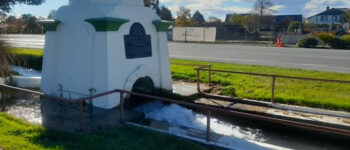1930: Kirwee Colonel
January 25, 2024
By AHNZ

Today in Canterbury history, 25 January, 1930, the monument at Kirwee was unveiled. It’s a wonderful and quite unique Art Deco interpretation of Ottoman domed architecture of the sort you wouldn’t expect to see in rural Canterbury. Yet, it’s quite appropriate to associate this 1870s water race and its prime mover: Colonel De Renzie Brett.
Before becoming a New Zealand pioneer, this Irish military man had served with high distinction while on loan to the sultan of Turkey during the Crimean War. The memorial mentions that the Ottoman’s decorated Brett as a knight of the Order of Medjidjie. It’s an interesting vantage point in 1930 to look back on mid-1850s Turks fraternally when the two time periods are separated by our attempted invasion of Turkey in 1915. It suggests a softening of regard for the Turk, helped along by Brett’s legacy, after what must have been characterised by anger and loss after the ANZACs at Gallipolli. Ref. 1915: Canakkale Victory and Martyrs’ Day, AHNZ
Colonel Brett became an even more famous hero during The Indian Mutiny where he helped rescue Henry Havelock and Henry Lawrence who were besieged at Lucknow. The importance of this to 1850s New Zealand is indicated by not 1, or 2, but 3 of our towns being named after those Henrys: Havelock, Havelock North, and Lawrence. Ref. 1857: Havelock History, AHNZ
Now 54 years old, Brett was ready to retire from the British Army and take on a new challenge in New Zealand as many returned soldiers from the Indian conflict did. Apart from retiring on full pay, the Colonel also came away from India with a massive pay-out. This allowed him to purchase a 1,000 acre property south of the Waimakariri River which he called Kirwee after one of his Indian engagements. Brett even planted the trees on his Kirwee estate to reflect troop deployment in that, his nostalgic, battle. The inspiration for Brett’s irrigation scheme also came from what he saw used in India.
So, we have a little bit of India, Turkey, and British Army pushed through the lens of 1930s Art Deco. All combined into a robust monument bestriding the first bit of the water race that Brett fought for and won which transformed his district.
“He was one of the prominent landowners in the district around this time and had named his property on Courtenay Road, ‘Kirwee House’ from the name of a fort he had captured during the Indian Mutiny…Work commenced in 1876 and by the end of 1877 the headworks and two miles of race had been completed and officially opened. One branch of the line followed the straight Tramway Road from Springfield to Rolleston, through Kirwee. The water race eventually reached Kirwee in 1881 and at this time Brett and other farmers in the area had (probably illegally) dug their own connecting irrigation ditches to extract water from the main race.” – Wayne Stack, Selwyn Times (2020,) Selwyn Stories
“Kirwee was in a dry area of permeable soil and needed water to prosper: Brett was to become most noted for his role in bringing irrigation to this area. He had, it seems, seen irrigation schemes in India, and determined for himself that the waters of the Waimakariri River could be used for this purpose. Elected to the Canterbury Provincial Council for Selwyn in 1870 and appointed to the Legislative Council in 1871, he was active in both bodies in advocating water races and mobilising farmer opinion..” – Dictionary of New Zealand Biography (1993,) Te Ara
“Back in the East Riding of Yorkshire, farmers on the drier land prospered. So the ‘Yorkies’ were drawn to the dry plains 28km west of Christchurch…The Yorkies worked the land as best they could for a decade or more, but the very thing that had drawn the farmers to the land around Yorktown became a major problem- its lack of water. Colonel Brett of Kirwee, who had observed irrigation systems in India, undertook investigations at his own expense…opened in December 1877. However, the years of struggle had taken their toll and, by the 1880s, most of the families had left Yorktown.”- Ref. p46 May Your Shadow Never Grow Less, Helen Thomas (2016)
De Renzie Brett, the Kirwee Colonel, arrived at a colony in crisis. Canterbury’s best land was now occupied but there was plenty more going to waste for want of access to water. Stock and people needed to drink and unlike Brett most could not afford a the deep wells required to reach Canterbury’s aquifers. “All water for farms that did not adjoin the riverbeds had to be carted in drays, and on Monday mornings long lines of drays carrying 400-gallon tanks waited at every watercourse to which there was road access…When the Courtenay Road Board was formed in 1865, its first task was to make dray tracks into the Waimakariri River. There was really no alternative.” wrote Rooney (1977.)
 For example, there was a vast area from the Waimakariri to Hawkins river frozen in winter and blasted and baked by nor’westers in summer; Useless as grazing land. “Until Colonel Brett’s scheme, that is.” noted Rooney. It simply wasn’t productive for settlers to have to physically lug water tanks by horse overland and, in the end, people were giving up and walking away from their farms. Had they not done so the district would still be known as Yorktown because these dry plains were populated by colonists from Yorkshire who thought they knew how to use dry land from their experience in England. However, they found out to their great cost that things were different here so Yorktown was abandoned. Two ‘Yorkie’ survivors were the Holland family, including Prime Minister Sidney Holland, and the Shipley family that led to Prime Minister Jenny Shipley. Instead, the locality is called Aylesbury.
For example, there was a vast area from the Waimakariri to Hawkins river frozen in winter and blasted and baked by nor’westers in summer; Useless as grazing land. “Until Colonel Brett’s scheme, that is.” noted Rooney. It simply wasn’t productive for settlers to have to physically lug water tanks by horse overland and, in the end, people were giving up and walking away from their farms. Had they not done so the district would still be known as Yorktown because these dry plains were populated by colonists from Yorkshire who thought they knew how to use dry land from their experience in England. However, they found out to their great cost that things were different here so Yorktown was abandoned. Two ‘Yorkie’ survivors were the Holland family, including Prime Minister Sidney Holland, and the Shipley family that led to Prime Minister Jenny Shipley. Instead, the locality is called Aylesbury.
Emperor Claudius completed the Aqua Claudia 2000 years ago for Rome but it was the initiative and political push of Colonel Brett that provided the highly successful Malvern water-race system. It made the arid plains productive at last. The first section of the race was officially opened on December 27, 1877, with speeches from Colonel Brett and Canterbury Province’s Superintendent (except that it had been abolished earlier that year) William Rolleston. “By 1880, the race had reached Waddington, where it branched, one part going to Kirwee and the other to Darfield” where a flour mill once straddled the main race through the township. “Brett and other residents with holdings at Aylesbury financed a private branch scheme to take water to Aylesbury, using a natural gully from Kirwee. Later this was taken over by the council. After that, progress was rapid, and by 1883 Colonel Brett .had seen his dream come true: water from the foothills of the Southern Alps, converted by man for his own use, was coursing across the Canterbury Plains not only to Rolleston but to Burnham and Norwood as well.” Ref. Rooney (1977)
It’s great to have this 1930 monument to remind us that today’s New Zealand was not simply inherited unimproved from Moa Hunters or Maoris. Our early colonists had to battle nature and government red tape to make wasteland productive. And, they didn’t always succeed on the first attempt. The achievement, and the water, belong to them and their inheritors. We ought to keep this history in mind in the 2020s when proposing new costs on the farmers to use the water that they themselves provided. Or, when considering divvying up the water rights as if it belonged to everyone so ought to be brought under national control. If water belonged to everyone in the 1860s and 1870s that didn’t save the Yorkies from being dried up and wiped out. It’s usable, accessible water that counts. Getting the water to where we and our animals need it makes all the difference. For anyone to take that for granted now only shows that our pioneers, settlers, and productive people have done their job too well.
—
Image ref. AHNZ Archives (2022)
Image ref. Trethewey statue, 1930s. One Hundred Crowded Years (1941), Archives NZ; Youtube
Ref. Derrick Rooney for The Press (1977,) Papers Past
Ref. 2017: Should farmers pay for water?, AHNZ
Ref. 1972: Otama Water Supply Scheme, AHNZ
2 thoughts on "1930: Kirwee Colonel"
Leave a Reply
 Like Comment Share
Like Comment Share






Another great article shining a light on the giants, whose shoulders we stand upon.
The engineering history of NZ is so little recognised. Thanks again for a well researched article.
Thank you, that’s exactly the response I’m looking for